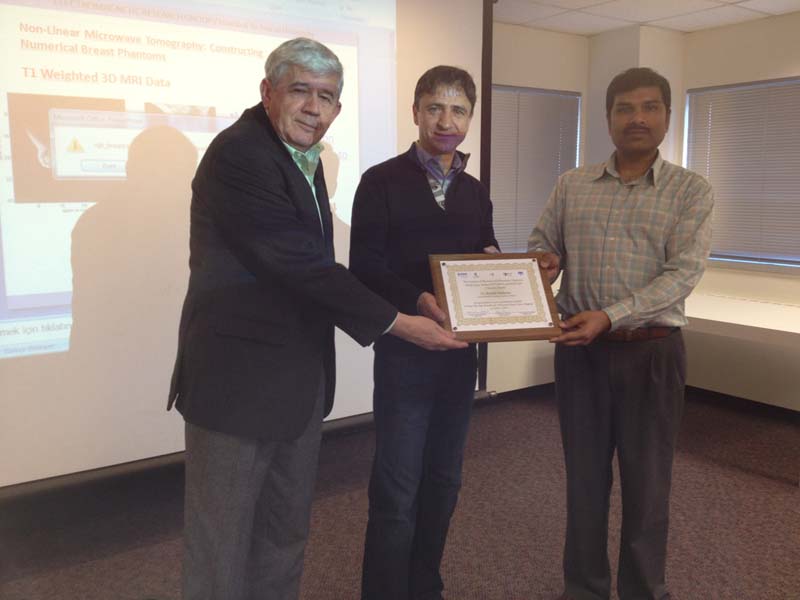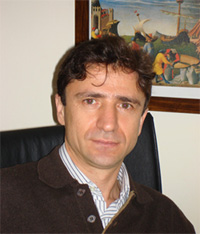A NOVEL TWO STEP PROCEDURE FOR MICROWAVE BREAST CANCER IMAGING
 One of the main treats for the woman's health is the breast cancer and a huge number of women lost their life every year. Today, early detection is the key approach in reducing the fatal effects of this disease and several approaches are in research progress in order to detect malignant tissues more accurately. On the other hand the use of electromagnetic waves in the microwave region for breast cancer imaging is becoming an emerging methodology. The experimental studies on the human tissues demonstrated that there is a significant contrast in dielectric properties between the malignant tumours and normal fatty tissue at microwave frequencies. The main motivation in using the microwaves for breast cancer imaging is that it is nonionizing, comfortable, sensitive to tumours, and specific to malignancies. Microwaves can also penetrate in lossy fatty tissue and their interaction with malignant tumours creates measurable scattered fields which can be used to extract information about the tissue dielectric-properties distribution or other tissue characteristics.
One of the main treats for the woman's health is the breast cancer and a huge number of women lost their life every year. Today, early detection is the key approach in reducing the fatal effects of this disease and several approaches are in research progress in order to detect malignant tissues more accurately. On the other hand the use of electromagnetic waves in the microwave region for breast cancer imaging is becoming an emerging methodology. The experimental studies on the human tissues demonstrated that there is a significant contrast in dielectric properties between the malignant tumours and normal fatty tissue at microwave frequencies. The main motivation in using the microwaves for breast cancer imaging is that it is nonionizing, comfortable, sensitive to tumours, and specific to malignancies. Microwaves can also penetrate in lossy fatty tissue and their interaction with malignant tumours creates measurable scattered fields which can be used to extract information about the tissue dielectric-properties distribution or other tissue characteristics.
In the present talk, it will be presented a new and effective microwave tomography approach for the breast cancer detection and imaging. To this aim, the breast is illuminated by a time-harmonic continuous electromagnetic wave at microwave frequencies through an antenna system moving on a semi-spherical surface over the breast and the scattered electric field vector is measured by the same antenna system. The imaging method given here consists of two steps. In the first step, the scattered electric field vector is analytically continued to the breast surface via surface potentials together with Taylor expansions and the inhomogeneous surface impedance is calculated through the standard impedance boundary condition. Then, the detection is achieved by observing the contributions of the malignant tissues to the surface impedance. The surface impedance is a function of the operating frequency, material properties of the malignant tumour and these features allow one to detect, approximately locate and classify the tumours. In the second step, the material (dielectric coefficient and conductivity) and geometrical properties (location and shape) of the tumour are determined through the modification of the Contrast Source (CS) approach to the new measurement configuration. The method requires the Dyadic Green’s function of the body-breast configuration and it is calculated here by the adaptation of the Buried Object Approach and accelerated by the method of discrete complex images. A microwave breast cancer imaging system prototype which uses above mentioned approach is also created and will be used in clinical trials soon.
Date and Time
Location
Hosts
Registration
-
 Add Event to Calendar
Add Event to Calendar
- Contact Event Host
- Dr. Ajay Kumar Poddar, Phone: (201)560-3806 (Email: akpoddar@synergymwave.com)
- Co-sponsored by MTT/AP & EDS CHAPTER
Speakers
 Dr. Ibrahim Akduman
Dr. Ibrahim Akduman
Biography: Dr. Ibrahim Akduman was born in Konya, Turkey in 1963. He received his BSc, MSc and PhD degrees in Electronics and Communication Engineering from Istanbul Technical University in 1984, 1987 and 1990, respectively. He worked as a visiting scientist at Polytechnic University, New York (1991), King's College London (1995), New Jersey Institute of Technology (2000), University of Goettingen, Germany (2001). He is a awareded as a Humboldt reserach fellow in 2001. He served as the Dean of the Electrical and Electronics Engineering Faculty at Istanbul Technical University between June 1999 and July 2001 and vice president of the same university between 2002-2004. He is currently head of Electronics and communication Department at Istanbul Technical University. He received the Turkish Scientific and Technological Research Council Young Scientist Award in 2000. His research interests are in the areas of direct and inverse scattering problems in electromagnetic theory, microwave breast cancer imaging, antenna theory, computational electromagnetics, integral equations. He has established two start up companies to convert his research results into products.
Address:ISTANBUL TECHNICAL UNIVERSITY, ELECTRICAL AND ELECTRONICS ENGINEERING FACULTY, MASLAK, , Istanbul, Türkiye, 34469
Agenda
5:00PM-6:00PM: Talk/Presenation
Free dinner will be served at 4:50PM. All are welcome. You don't have to be IEEE member to attend the talk

